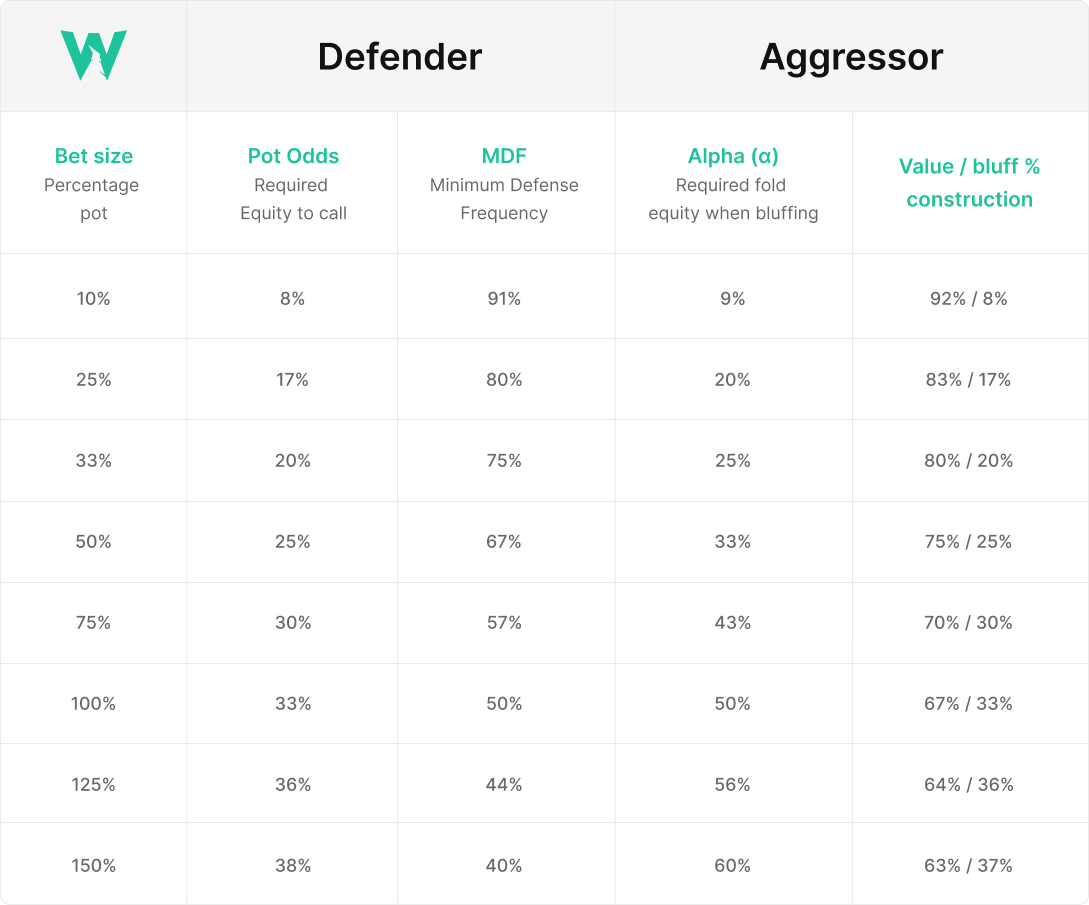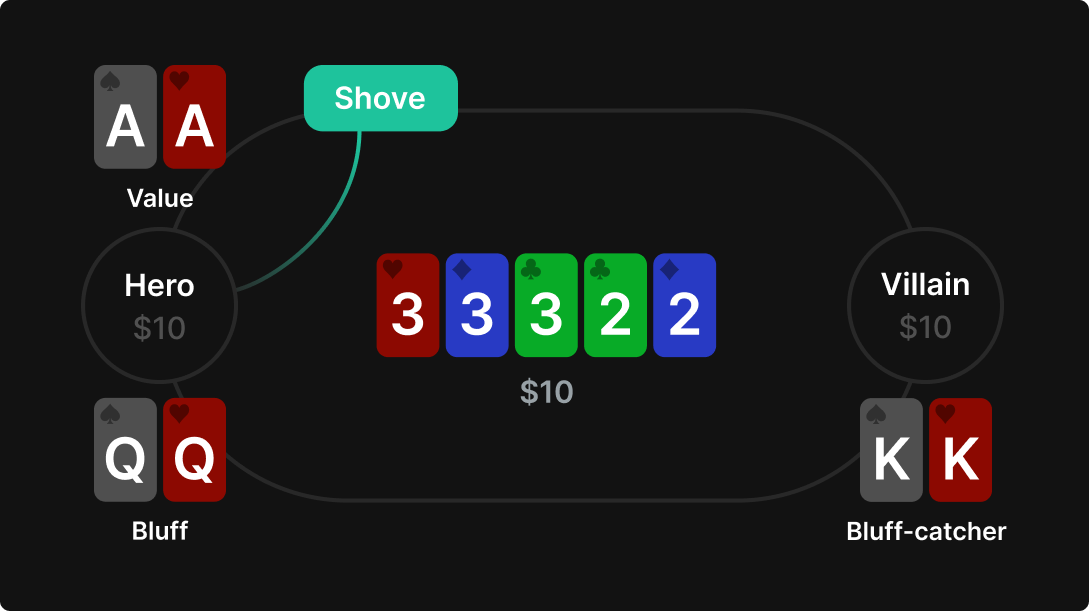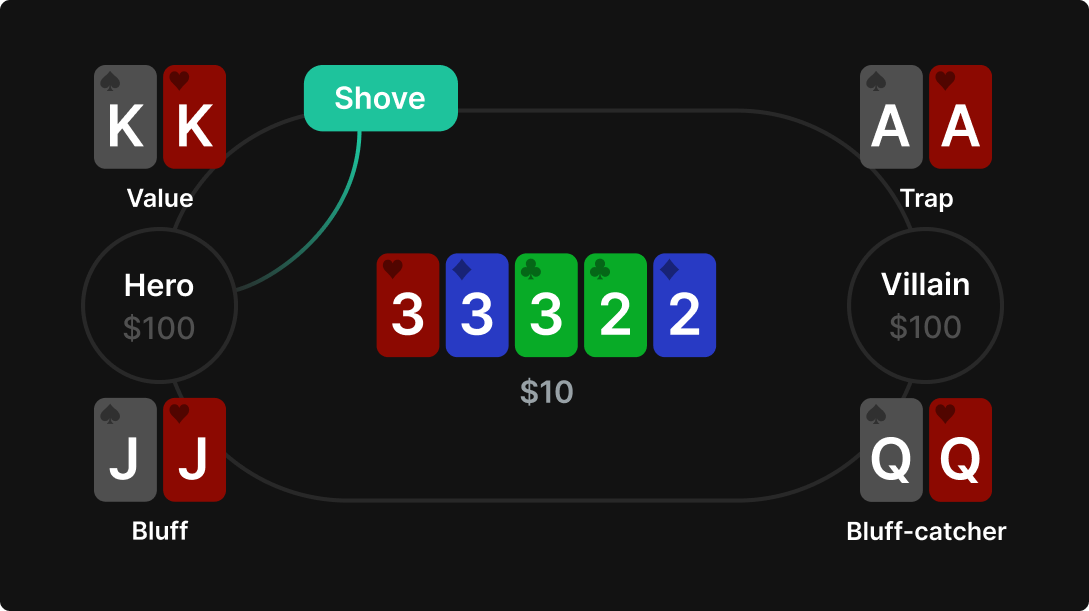How to solve toy games
Toy games are simplified versions of poker that we can use to understand the game theory on a deeper level.
Poker is a complicated game. It’s impossible to calculate GTO strategies on the fly. By reducing it to a toy game, we can solve it by hand, and learn the fundamental incentives of game theory optimal poker.
This article is just an introduction that will cover some of the basics to get you started.
Learning these games won’t turn you into the next Linus. But they will indirectly improve your poker ability by helping you understand and interpret solvers more effectively.
I’ll cover two versions of the polarized vs bluffcatcher toy game in this article. This serves as an introduction to solving toy games.
The Basics
In order to understand toy games, you need to learn a few basic functions such as pot odds, MDF, and how to set up an expected value calculation.
- MDF tells us how often the defender needs to call to make our bluffs indifferent.
- Pot Odds tell us how much equity the defender needs to call, and informs our bluff/value ratio.
- S = Bet / Pot
Check out these articles if you don’t know how to do that!
Here’s a handy cheat sheet you can use in order to quickly calculate everything!
Polarized vs Bluffcatcher
A polarized vs bluffcatcher toy game is a situation where one player has either the stone cold nuts, or a complete bluff. The other player has a bluff-catcher.
- Player 1 (acts first): Holds either AA or QQ at equal frequency.
- Player 2: Holds KK
- The board is: 22233
- The pot is 10, the stacks are 10. Either player can shove or check
This is sometimes called the “clairvoyant game”, since player 1 always knows if they are ahead or behind, and KK may as well be face up.
Now how do we solve this game? Let’s break it up into 4 steps.
- Eliminate dominated strategies – figure out “pure actions” with logic.
- Calculate bluff to value ratio using pot odds.
- Calculate how often the defender should call using MDF.
- Generalize the equations for good measure.
Step 1) Start by eliminating dominated strategies!
If we check, KK will always check behind. It doesn’t make sense for KK to bet as that would simply fold QQ and get called by AA. KK should simply check behind and win against QQ without risking anything. Therefore, AA should always bet!
Step 2) Calculate bluff to value ratio
We know AA should always bet. How often should we bluff? If we bluff too much, KK can exploit us by always calling. Too little and they exploit by always folding. So the optimal strategy is to bet in a way that makes KK “indifferent” between calling and folding.
Look at the pot odds laid. This is a pot-sized bet, so villain needs 33% equity to call.
Required equity = (call amount) / (pot after they call) = 1/3
Therefore, ⅓ of our betting range should be bluffs. If we always bet AA, then we need to balance by bluffing QQ half the time. That way, we lay the exact odds needed to give villain 2:1 on a call, and they can’t exploit us.
Step 3) Calculate how often KK should call
If KK folds too much, we can exploit them by always bluffing. If KK doesn’t fold enough, we can exploit them by never bluffing and just own them with value bets. So their best strategy is to call often enough to make our bluffs indifferent between betting and checking!
This is where MDF comes in. The frequency that they call is a function of our bet size.
MDF = pot / (bet + pot) = ½
So KK should call exactly half the time. They should randomize between calling and folding to avoid being exploited!
Let’s summarize. AA always bets. QQ bets half the time, and checks half the time. KK calls half the time, folds half the time, and always checks behind when checked to.
Step 4) Generalize it!
What if the bet size was different, though? What if we had more value or more bluffs in range? For this toy game, the general solution is a function of bet size.
Let ‘s’ = bet/pot
- Always bet AA
- Bluff QQ often enough to give them exact pot odds
- Call KK according to MDF
Rewriting MDF with s: KK call% = 1/(1+s)
Rewriting Pot Odds with s: Required equity = s/(2s+1)
KK’s equity facing a bet can be written as the percentage of bluffs in the betting range. Set that equal to the required equity to make KK indifferent!
Bluffs / (Value + Bluffs) = s/(2s+1)
Quiz
Pot = 10, Bet = 7
Player 1 has: 5 combos of AA, and 6 combos of QQ
Player 2 has KK
Take a moment to try and calculate this yourself before looking at the solution!
Click here to see the answer
Dominant strategies: AA should always bet, KK should always check if allowed.
s = bet/pot = 7/10
We’re betting 70% pot. Let’s plug 0.7 into the equations!
MDF = 1/(1+s) = 1/1.7 = 58.8%
KK should call 58.8% of the time facing a bet to make bluffs indifferent.
Bluffs / (Value + Bluffs) = s/(2s+1)
Let’s plug in 5 for value, and 0.7 for s:
Bluffs / (5 + Bluffs) = 0.7/2.4
Rearrange and solve
Bluffs = 0.29 x (5 + Bluffs)
Bluffs = 1.45 + 0.29 Bluffs
Bluffs = 2.058
We should bluff 2.059 out of 6 combinations of QQ. So QQ should bluff about a third of the time.
Polarized vs Bluffcatcher with traps
So you know how to calculate the basic polar vs bluff-catcher toy game. What happens when the defender has traps though?
The setup
Villain checks to us on the river, 22233. We know villain’s range is 90% bluff-catchers, 10% traps that beat our value bets. We’re in position with 50% value hands, and 50% pure bluffs.
Villain (out of position): 90% QQ, 10% AA
Hero (in position): 50% KK, 50% JJ
The board is: 22233
You can bet any size you like!
Villain can only call or fold.
If villain didn’t have any traps we could just shove to give them the worst odds possible and make the most money! In this toy game, however, our value hands can be beaten by traps. If we bet too big we donate too much money to their traps. If we bet too small, we don’t extract enough money from their bluffcatchers.
The reason I love this toy game is because it demonstrates a fundamental principle of bet sizing theory:
How do we find the “perfect” bet size?
Solving the toy game
Let ‘s’ = bet/pot
Let ‘t’ = % of traps in villain’s range
Let ‘q’ = Hero equity with value when called
Let ‘c’ = Percentage of time villain calls
Step 1) Figure out how wide they call
When we bet, they should defend according to MDF. However, their traps will never fold, so we need to make a small modification.
Calling% (c) = Max ( MDF, traps%) = Max (1/(1+s), 10%)
In other words, they defend MDF, but their calling frequency never drops below the percentage of traps in their range (10% in this example).
Because they are defending according to MDF, our bluffs will always be 0EV.
Step 2) Calculate our equity with value hands when called
Remember, our value loses to traps, so we need to figure out the equity of our value hands when called, then create an expected value equation.
Our equity when called is a function of bet size. The larger we bet, the more bluff-catchers fold, leaving proportionally more traps in their calling range. Therefore, the equity of our value hands (q) equals the proportion of bluffcatchers to traps that villain calls.
Equity when called = bluffcatcher% in calling range = (call% – trap%) / call%
q = ((c-t) / c)
Step 3) Calculate your expected value
We need to figure out an equation that represents our expected value when betting. The optimal bet size will maximize our EV!
The EV of our bluffs is 0 since villain calls according to MDF (although it might be negative if we bet too big, but let’s ignore that). We can skip this part since adding 0 to our EV doesn’t change anything.
That just leaves the EV of our value hands.
EV (value bet) = call%(EV when called) + fold%(pot)
EV (value bet) = call%(win% * (pot + bet) – (lose% * bet)) + fold%*pot
That’s a bit cumbersome, so let’s replace this with variables:
- Bet% = s
- Pot = 1 (we’ve normalized the pot since s = bet/pot)
- Call% = c
- Win and lose% = q and (1-q) respectively.
EV (value bet) = c(q(1+s) – s(1-q)) + (1-c)
We can take this a step further and substitute q, but this isn’t required unless you want to solve this analytically.
EV (value bet) = 1+s(c-2t) – t
Step 4) Graph the expected value by bet size
The easiest way to find the optimal bet size is to simply graph the expected value against the bet size and then pick the highest point on the graph!
Play with the graph! I’ve created a simple calculator you can use to graph the EV as we plug in different values for the number of traps. Simply drag the t slider.
Graphing this function shows that if villain has 10% traps, then our optimal bet size is 123% pot. Although realistically, anything between 100%-150% gives us close to the same EV.
Now some of you may want an analytical solution. To solve that, you’d need to use calculus. More specifically, you’d want to find the argmax ‘s’ that maximizes EV (value bet). Calculus is beyond this video’s scope, and I think simply graphing the EV is much easier. But for completion:

Watch the full video!
The full video goes over many other toy games, including:
- Polar vs bluffcatcher
- Polar vs bluffcatcher with traps
- Bluffing with draws
- Multistreet polar game
- [0, 1] game
Further reading
Learning toy games can be fun while providing you a deep knowledge of game theory that can translate into better play. We’ve only skimmed the surface today.
Check out these books to learn more about how to solve toy games:
- Expert Heads Up No Limit Hold’em, Volumes 1 & 2 by Will Tipton
- Play Optimal Poker, Volumes 1 & 2 by Andrew Brokos
- Modern Poker Theory by Michael Acevedo
- Mathematics of Poker by Chen & Ankenman
Author
Tombos21
Tom is a long time poker theory enthusiast, GTO Wizard coach and YouTuber, and author of the Daily Dose of GTO.




















































































































































































































































